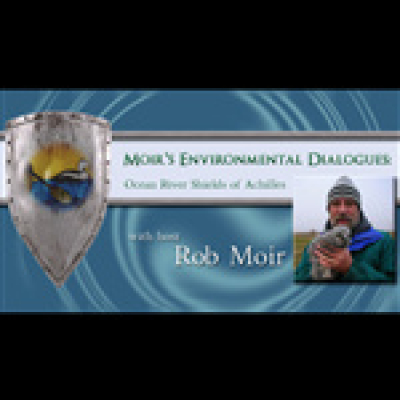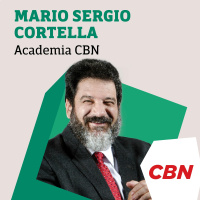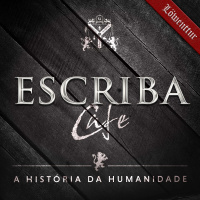Synopsis
With the knowledge of Carson and the courage of Achilles, individuals are steadfastly going the distance to defend wildlife and ecosystems from assaults of environmental degradations and destructions. Join environmental studies scientist Dr. Rob Moir for lively dialogue and revealing narrative inquiry into how individuals are overcoming the obstacles turning forlorn hope into effective actions for oceans, rivers, watersheds, wildlife and ecosystems. Discover how listening to individuals, thinking locally, and acting in concert with other, you can act to save ecosystems. Got environmental stewardship? Become an Eco-steward. Act to bring about a greener and blue Planet Earth. Moirs Environmental Dialogues is broadcast live every Thursday at 12 Noon Pacific Time on The VoiceAmerica Variety Channel.
Episodes
-
Special Encore Presentation: Striped Bass and Massachusetts Fishermen
07/12/2011 Duration: 50minDarren Saletta has caught Striped Bass by hook & line for 20 years. The Striped Bass fishery is a well managed, clean, environmentally sound operation with plenty of fish. Industrial fishing operations are destroying the striper’s food base. Herring, Mackerel, & Menhaden are caught in massive nets that can kill tons of by-catch, including Striped Bass. Water quality is an issue for Striped Bass in the Chesapeake. Burgeoning Gray Seal populations are fouling inshore waters with excessive waste and decimating inshore forage, forcing Striped Bass to feed much further offshore to the dismay of surf fishermen. Seals are also cleaning out fishing weirs, another environmentally favorable method of commercial fishing. Striped Bass fishermen are under attack by a special interest group attempting to close the fishery, stripping us of the ability to buy Striped Bass at fish markets or restaurants. Discover what you can do to protect Striped Bass and this culturally significant fishery.
-
Striped Bass and Massachusetts Fishermen
30/11/2011 Duration: 50minDarren Saletta has caught Striped Bass by hook & line for 20 years. The Striped Bass fishery is a well managed, clean, environmentally sound operation with plenty of fish. Industrial fishing operations are destroying the striper’s food base. Herring, Mackerel, & Menhaden are caught in massive nets that can kill tons of by-catch, including Striped Bass. Water quality is an issue for Striped Bass in the Chesapeake. Burgeoning Gray Seal populations are fouling inshore waters with excessive waste and decimating inshore forage, forcing Striped Bass to feed much further offshore to the dismay of surf fishermen. Seals are also cleaning out fishing weirs, another environmentally favorable method of commercial fishing. Striped Bass fishermen are under attack by a special interest group attempting to close the fishery, stripping us of the ability to buy Striped Bass at fish markets or restaurants. Discover what you can do to protect Striped Bass and this culturally significant fishery.
-
Acidifying Oceans Are Killing Oysters and Oyster Farms in Oregon
16/11/2011 Duration: 56minVicki Osis, marine education professor of Fisheries and Wildlife, Oregon State U, tells how increasing acidity of the ocean was first documented by scientists researching around the globe. Carbon-loading of the atmosphere is having serious effects on the Ocean with increasing devastations of epic proportions expected by 2020. Already oyster larvae are perishing, wiping out oyster growing businesses in Oregon. And oyster sprats are just one in the cast of thousands of species that make up ocean zoo plankton. When the base of food chains fail entire suites of animals risk sudden extinction due to no food including striped bass, tuna and both baleen and toothed whales. The only way the oceans can be saved is by Americans reducing our carbon footprint. When 4% of the world population is responsible for 20% of the carbon into the atmosphere problem, we must lead the way in actions. Those who like to eat oysters will soon not be the only ones to suffer when carbon kills the ocean.
-
The Greening of Fitchburg, Massachusetts
02/11/2011 Duration: 54minMayor Lisa Wong takes Rob down to the Nashua River that is the reason for this New England industrial town. Once the river ran through mill factories; now walls that canalized and accelerated are coming down with the building of three green parks. Andria Freeman of the Trustees of Reservations, DPW Commissioner Lenny Laakso and Bob Jokela, Business Manager of the Fitchburg Public Schools all tell of their respective effort to green the city and strengthen community. When police cruisers are retired, reducing carbon footprint with donated motorcycles and pedal bicycles, not only do police interact more closely with community, a group of high school seniors ask the Mayor how they can become Fitchburg policemen. Hear why similar requests are being made of DPW, Parks & Recreation, and schools. The Fitchburg Mayor faces a tough reelection vote on November 8, 2011 due to out-of-town factors.
-
Atlantic Menhaden Overfished and a New Documentary Film: Shored Up
12/10/2011 Duration: 58minJud Crawford, Ph.D. of the Pew Environment Group introduces a plankton-eating fish that is forage food for fish, birds and marine mammals. The Atlantic menhaden have been called the most valuable fish in the sea. The ecology of menhaden is described and a new initiative to restore menhaden by increasing the number left in the ocean and for finally taking into account the needs of menhaden predators. And so Castles Made of Sand Fall into the Sea, eventually… (Jimi Hendrix) Ben Kalina introduces his new documentary film, Shored UP. Ben experiences life on a barrier beach by spending a hurricane on Long Beach Island, NJ when all have left except for rescue personnel. Ben describes beach life on Long Beach New York where surfers arrive be subway. Shored Up is a feature documentary about our disappearing coasts and our irrational yet romantic urge to live on the edge of a sea that surges with unimaginable power.
-
River Herring and the Mystic River, Over Dams by Bucket, Death by Bycatch
05/10/2011 Duration: 55minE. K. Khalsa, Executive Director of the Mystic River Watershed Association (mysticriver.org) talks about the challenges of being a river hearing in the sea and in the river. He spoke on behalf of herring to the New England Fisheries Management Council and offers concrete actions one can take to save herring. The Fisheries Council is offering a short public comment period after years of research and deliberations. The Mystic River is alive with herring thanks to people turning out to lift fish over a dam and then the building of a successful fish ladder. Hardened shorelines and impervious watershed lands are a great problem that is being addressed from “depaving” neighborhood events to remediation of hazardous industrial corridors into green ways with natural filters and no toxins. With roughly 12 million herring lost every year to bycatch at sea, now is the time to speak up for herring – herring for our rivers, our tables, ecosystems both marine and fresh water.
-
An Ecosystem-based Fish Habitat Ocean Research Area for Stellwagen Bank National Marine Sanctuary
28/09/2011 Duration: 55minRob’s guests are Stellwagen Bank National Marine Sanctuary Craig McDonald and John Williamson, Fisherman, New England Fisheries Management Council former member representing fishermen from two states, and now president of Stellwagen Alive. After nineteen years of Sanctuary management and research, a proposal to close 14% of the area to fishing has been developed. Stellwagen Bank Sanctuary in its entirety has four bottom types, one third gravel, one third sand, one third mud and a bit of boulders. Subarea A, the 89 square miles to be closed (14% of 640 sq mi Sanctuary) also contains a third gravel, sand and mud plus boulders. Subarea B, 106 sq mi to the east, is proposed to be closed to commercial and open to recreational fishing; while subarea C 56 sq mi to the north, closest to Gloucester, would be closed to recreational fishing and open to commercial. Why ecosystem-based research is so important along with population-based research is explained. How the Sanctuary arrived at these specific research areas
-
Troubles In Florida’s Indian River Lagoon
07/09/2011 Duration: 56minWhat is happening to Florida’s Indian River Lagoon and what homeowners can do for healthier Lagoon wildlife? George Jones, the Indian River Lagoon Riverkeeper, tells Rob about the uniqueness of the Lagoon and the importance of staying vigilant in protecting this invaluable resource. Jim Egan, Executive Director of the Marine Resources Council, tells of the current problems facing the Lagoon, what is causing them, and what people can do. Capt. Nancy Beaver joins the program later on to echo the alarm for the dying of seagrass beds that are being blotted out by algal blooms. Martin County Commissioner Patrick Hayes joins the conversation and comes to the rescue with an ordinance passed just before the summer rains arrived banning the application of lawn fertilizers from June 1 through September 30th as well as other measures to save Indian River Lagoon.
-
Dwindling Herring and Clearing the Coastline
24/08/2011 Duration: 56minMatt McKenzie, Ph.D.,UCONN & Patrick Paquette, striped bass fishing community organizer say where have all the herring gone, how Cape Cod has changed. McKenzie tells the social and ecological history of the rise and demise coastal fisheries in the 19th century. His book: Clearing the Coastline, includes Thoreau’s thoughts on Cape Cod fisheries and how these changed after his death.Matt also tells of helping out a family’s herring weirs on Cape Cod and of a fisherman well known to Paquette.Patrick explains early efforts to save herring through the CHOIR collaboration“where different voices needed to learn to sing in harmony.”He also noted a striped bass food shortage along the East Coast caused by industrial-scale fishing of coastal herring, mackerel and menhaden. NMFS and the New England Fishery Mgmt Council failed to take measures to stem the decline of sea herring, river herring, and shad populations. Visit Ocean River Institute for how you can help w ORI’s lawsuit to save herring.
-
Humpback Whales Bubble-Netting on Stellwagen Bank National Marine Sanctuary
10/08/2011 Duration: 58minLes Kaufman, CI and Boston University professor along with John Williamson, president of Stellwagen Alive talk with Rob about their whale watch voyage onto Stellwagen Bank August 5th where forage fish were running strong and humpback whales feeding voraciously. Les Kaufman explains the biology and feeding behaviors of humpback whales. John Williamson tells of decades working as New England fisherman often on Jeffrey’s Ledges. Williamson, nominated by two states (NH and ME), served on the New England Fisheries Management Council. He explains the work of managing fish populations where the corner has been turned on over fishing for sustainable seafood, and of the need for more ecosystem-based research. Stellwagen Alive, John’s friends group for the Sanctuary is actively recovering lost fishing gear http://www.stellwagenalive.org For more info on Stellwagen Bank National Marine Sanctuary visit http://stellwagen.noaa.gov
-
Working Towards a Greener and Healthier British Virgin Islands and the Benefits of Sustainable Living with Clean, Renewable Energy
27/07/2011 Duration: 55minCharlotte McDevitt, Executive Director of GreenVI.org, is working towards a vision of a green, clean, healthy and prosperous British Virgin Islands. Since 1995 trash on Tortola has surged from less than 10,000 tons to close to 40,000 tons. Charlotte explains why due to the nature of Tortola they must burn trash and what is being done to reverse that trend. Twice a year for a few days the incinerator has to be shut down so that people could scrape off the internal walls melted glass. Charlotte explains how with the help of businesses, Islanders are rallying to recycle and reuse glass. This includes a method that is saving the coral reefs and mangrove shores. See a video of their glass studio at GreenVI.org. BVI was awarded UNESCO funding for Environmental Education that emphasizes Sustainability. Be inspired by what an island community is doing with very limited resources to reduce their pollution and carbon footprints.
-
River Rafters to Cow Power, Wal-Mart’s Green Revolution is Good for Economy
13/07/2011 Duration: 57minSustainability is good for business. Ed Humes, Pulitzer Prize-winning journalist and author discusses his latest book: Force of Nature: The Unlikely Story of Wal-Mart's Green Revolution (Harper Collins, May 2011). The giant “box store” discovers that going green to address one’s carbon footprint saves money, no matter the product. Systems thinking where “carbon equals energy equals money” saves Wal-Mart’s bottom line. Discover Daisyville, cow power and the cow of the future. The pasteurization method is as much to blame for a cow’s carbon and methane footprint as is the cow. Grazing on grass is just one of the many steps diary farmers are now considering. A company can only save the planet if it can inspire all companies to make ecosystem services a market force. Hear about first corporate steps and partnerships on the quest of sustainability for planet Earth.
-
Grass, it’s What Cows Want to Eat, Good for Cattle, Better from Environment, Healthier Us.
22/06/2011 Duration: 53minLeslie Cox, Hampshire College Farm Center Manager talks with Rob about cow and grass management for happier cows, healthier consumers and a greener nation. The Farm, created by Prof. Ray Coppinger, is a place where college students and faculty integrate science and alternative technology for testing sustainable farming methods. The cows are Dutch Belted, a very rare and highly esteemed breed, developed in the Netherlands in the 1600s. With an excellent grazing ability and forage efficiency, these cows produce as much milk as larger, grain-fed cows. Known for intelligence and friendly disposition, except for Bethany who is short on the friendly but not intelligence, the cows handle easily and are “barn-trained” to do their business outside. Emitting less methane, grass-fed cows and cattle are good for the environment. An attractive alternative to the carbon footprint created by the production and transport corn.
-
Fishermen and River Herring Advocates Challenge Latest Herring Plan
08/06/2011 Duration: 57minPam Lyons Gromen, Executive Director of the National Coalition for Marine Conservation (NCMC) and Earthjustice’s Roger Fleming talk about where have the herring gone on Moir’s Environmental Dialogues and on Moir’s Environment Advocates. When NMFS and NEFMC failed to stem the decline of sea herring, river herring and shad populations, a recreational fishing advocate, charter boat captain, and the Ocean River Institute filed suit, represented by Earthjustice. Pam describes the life history of fish and explains why these fish are in jeopardy. Roger explains why a lawsuit is necessary when groups fail to act and what will be accomplished through our actions. Rob, Pam and Roger are active members of the Herring Alliance, a coalition of non-profit conservation and environmental organizations working to reform New England’s Atlantic herring fishery. The protection and restoration of river herring, shad, and Atlantic herring, is vital to the continued use and enjoyment of these waters.
-
Fog Warning: NH’s Gundalow and Homer’s Dory Man with Halibut
01/06/2011 Duration: 55minMolly Bolster, Executive Director of the nonprofit Gundalow Company http://www.gundalow.org and Jeff Bolster, Professor of History at the University of New Hampshire, talk with me about marine environmental history informing today’s ocean conservation and stewardship. We must understand the oceans of the past to protect the oceans of the future. According to a recent report the state of rivers and Great Bay that flow into Portsmouth NH are declining according to 11 out of 12 indicators. Molly Bolster addresses these trends by using a replica boat, modeled after the last gundalow, as an educational platform. A new gundalow is being built which poses challenges of its own. Jeff Bolster describes how skewed visions of the past have led to disastrous marine policies and why historical perspective is critical to revitalize fisheries and ecosystems. In The Fog Warning by Winslow Homer Jeff gives us new insights into ocean conservation.
-
Leviathan, The History of Whaling in America with Eric Jay Dolin
25/05/2011 Duration: 57minEric Jay Dolin, calling from Marblehead, tells us about the history of whaling with a bit about the beginning of the whale watching industry and Stellwagen Bank National Marine Sanctuary. Discover how Capt Smith had he caught whales would have set up a colony in Massachusetts before the pilgrims. Whaling started in Boston in 1640 with Samuel Maverick setting up a whale processing shop on Noddles Island, now East Boston, for “drift whales.” Eric Dolin explains why first Nantucket and then New Bedford became the capitals of the 19th century “oil barons.” American whaling ebbed away not due to a lack of whales to kill but due greatly to the finding of oil and the rise of new energy technologies. The similarities between business and social challenges than and today are startling. Tune in for whale struggles, greasy prosperity, killings just for corset stays, and the Wanderer’s last voyage.
-
How Green is Senator Brown?
11/05/2011 Duration: 53minCitizens of Massachusetts are outraged that U.S. Senator Scott Brown has voted repeatedly to eliminate clean air standards. People are feeling betrayed by a former state senator who voted green more often than not (MLEV’s scorecard). When $1.3 million dirty fossil fuel money went into the Senator’s campaign chest, he did “a Jekyll-Hyde switch between Beacon Hill and Capital Hill.” The League of Women Voters called Brown to task. After thirteen days of withering attacks LWV still stands tall. Now the Mass League of Environmental Voters has taken out radio ads: he “repeatedly voted to eliminate clean air standards that keep dangerous pollutants like arsenic, mercury and lead out of the air.” Joining me to talk how green is Brown are Erik Blasbaugh, Acting Executive Director of the Massachusetts League of Environmental Voters, Ben Wright, Advocate for Environment Massachusetts, Vanessa Rule, Director, The Better Future Project and Jason Kolwaski, Policy Director, 350.org.
-
Saving Amazon Rainforests with Olivia Newton John and Amazon John Easterling; Washasha X Sings Ras Mangrove
20/04/2011 Duration: 57minOlivia Newton-John and her husband Amazon John Easterling talk with Rob Moir on what we each can do for a greener planet and about their work to save the Amazon Rainforest. Olivia tells why the rainforest is so important. Amazon John explains the remarkable health-giving properties of the Camu-camu fruit (www.DrinkCamu.com). This indigenous fruit is harvested from shallow boats and is a source of income for local peoples. In the 2nd half, Rob talks with Bert Lettsome, a.k.a. 'Washasha X', Chief Conservation Officer of the British Virgin Islands and the work of the Virgin Island Environmental Council. Bert describes why nature in the British Virgin Island is more diverse than anywhere else in the Caribbean. To protect it and maintain pristine, undisturbed nature in the Virgin Islands, we must all make choices. Listen to his song “Choices.” Bert tells us why mangroves are so vital with his song “Ras Mangrove.”
-
North America Mother Earth Water Walk from the 4 Compass Directions with a copper pail of seawater.
13/04/2011 Duration: 54minWhat began with 4 Anishinawbe Grandmothers quickly included women and men walking to raise awareness for the water Water is precious and sacred; it is one of the basic elements needed for all life to exist. They walked around the Great Lakes and the St Lawrence to the sea. Each of the 24,113,700 steps taken was a prayer for the water. Now the 2011 Mother Earth Water Walk to Wisconsin from 4 directions has begun. April 10, 2011, at Olympia, Washington, under the watchful eyes of loon and bald eagle, water from the Pacific Ocean was collected in a copper pail. Walkers will gather sea water in Gulfport, Mississippi, Machias, Maine and Churchill, Manitoba and walk the waters to Bad River, Wisconsin. Telling me of the epic endeavour are Dawnis Kennedy, Joanne Robertson (coordinator) Sharon M. Day (South), Tina (West) and Madeleine Huntjens (East).To learn more and to assist please visit http://www.motherearthwaterwalk.com or view their progress at http://emptyglassforwater.ca/map/














